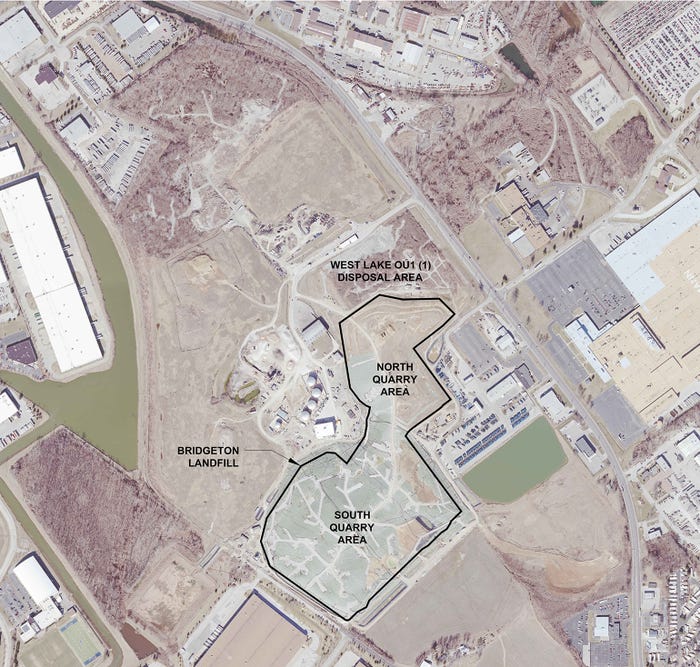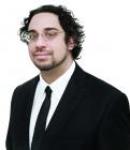An exothermic reaction at the Bridgeton (Mo.) Sanitary Landfill that began nearly six years ago continues to smolder. This is a concern because of low-level radioactive material that was disposed of at the adjacent West Lake Landfill in 1973.
The situation, at times, has led to big concerns being expressed by the community. And Missouri Attorney General Chris Koster has pursued legal action against the site.
How it’s being handled serves as an important lesson for the industry for several reasons. Reactions and elevated temperatures at landfills are an industry-wide concern. The lessons learned from managing the reaction at Bridgeton could have wider applications within the industry.
It’s a confusing situation, as well, in part because the reporting on the subject has been a bit frenetic. In most cases, it’s talked about as an underground fire, which is technically incorrect. And anytime radioactive material is involved, alarm bells get raised.
Last fall, there was a bit of a panic within the community surrounding the site. Heated rhetoric stoked fears about the reaction reaching the radioactive material, and the community expressed concerns. Since then, the furor has died down. Meanwhile, Republic Services, which acquired Bridgeton Landfill in 2008 as part of the much larger acquisition of Allied Waste, has continued its efforts to effectively manage the reaction.
“I think we’re very close to a day when the community appreciates that we had the keys and instead of walking away, we’ve done what’s right,” says Russ Knocke, a spokesperson for Republic Services. “As a result, we feel like Bridgeton as a community has its brightest days ahead of it.”
Here is what you need to know about the situation in Missouri.
Where is the Bridgeton (Mo.) Sanitary Landfill?
Bridgeton is a suburb of St. Louis in northwestern St. Louis County. It has a population of about 11,500 people. The West Lake Landfill and Bridgeton Landfill sit about 20 miles from downtown St. Louis.
Why is there radioactive material in the landfill?
According to a history of the site compiled by KSDK.com, the West Lake Landfill began as a limestone quarry operated by the Westlake Quarry Company in 1939. Municipal solid waste landfilling operations began in the 1950s. In 1973, 8,700 tons of low-level leached barium sulfate and 39,000 tons of soil were mixed and used as daily top cover at the site. In 1990, West Lake officially became listed as a Superfund site, meaning the Environmental Protection Agency (EPA) has jurisdiction over the site.
The landfill contains two operable units (OU-1 and OU-2), both of which contain low-level radioactive material. Soil samples indicate the presence of leached barium sulfate cake, Uranium and Thorium.
According to a spokesperson for Republic Services in 2015, "The reference to leached is relevant. It was actually leached twice, meaning that Mallinckrodt squeezed every isotope of value out for purposes of their work. The higher-level materials that were not used were shipped out to Canyon City, Colo. The low-level leached barium sulfate is what was left behind and eventually mixed in with soil as top cover."
Where is the reaction and when did it start? How close is it to the radioactive material?
In December 2010, landfill contractors detected early indicators of a possible exothermic reaction in the South Quarry of the Bridgeton Landfill. In the nearly five years since, the reaction has moved in the opposite direction of West Lake Landfill and remains contained in the southernmost portion of the South Quarry. The Bridgeton Landfill is divided into North and South Quarries that are connected by a narrow band called a “neck.” The adjacent West Lake Landfill is located to the north of the North Quarry of Bridgeton Landfill.

In early September 2015, Koster raised the alarm further by releasing a report saying the reaction could reach the radioactive material within three to six months and that it is out of Republic’s control. That did not happen.
For its part, the EPA disputed that report saying it “strongly disagrees” with Koster’s assertions and there is no risk to surrounding communities. Republic has also responded to the report. Additionally, in a sworn deposition, the lead author of the Koster report reversed many of his findings.
Additionally, Republic maintains a website dedicated to the Bridgeton Landfill that features weekly official reports it files with the state regulator for the Landfill, Missouri Department of Natural Resources.
Why has the reaction continued for so long?
Because the exothermic reaction is occurring 60 to 150 feet beneath the surface of the landfill where there is no oxygen present, the reaction cannot be extinguished. It will have to self-extinguish. But since the reaction is occurring at high temperatures, the use of the cooling system can slow the reaction down and help keep it isolated.
Figuring out how to extinguish a subterranean reaction is a difficult challenge.
At Bridgeton, the reaction is occurring 60 to 150 feet below the surface. It’s in areas where materials are likely soaked with leachate and where there is little-to-no oxygen. Therefore, the reaction is a smoldering, much like a compost, without it ever breaking into flames.
According to a piece on fivethirtyeight.com:
When Todd Thalhamer, a waste management engineer and landfill firefighter based in California, tracks smoldering fires beneath other landfills, he does it by breaking open one side of the trash pile and following the trail of plastic bags. “As you get closer to the direction of the smolder the white plastic bags will start turning a light tan, a darker tan and eventually they’ll become a gummy black,” he said. When he reaches the heart of the smolder, the air that came in with him will sometimes cause it to burst into flames. But otherwise, what smoldering fires “look” like is a trail of hot, partially combusted material and a low-lying haze of gas.
What has Republic’s approach been to containing the reaction?
In September, the landfill’s operators completed the installation of 16 additional cooling points in the neck area between the Bridgeton Landfill’s North and South Quarries.
The addition brings the total number of cooling points in operation at the site as part of an innovative heat extraction system to 28.
The cooling points are part of Republic’s proprietary heat extraction system that is engineered to circulate temperature-treated water through a closed-loop line. The cooler water extracts heat as the water circulates through the closed loop. The system is designed to return warmer water to a chiller temperature for both re-cooling and re-circulation. The cooling points vary in depth and can be as deep as 180 feet beneath the surface level. The system serves as a redundancy capability, or additional tool, for containing the heat generating subsurface reaction occurring in a portion of the landfill’s South Quarry.
Republic first introduced the heat extraction system as a pilot program in fall 2013. Based upon early success, the original pilot program was expanded in June 2015. Last April, the landfill team and the EPA agreed to more than double the system by adding an additional 16 cooling points. Construction on these latest cooling points began in July and was completed by the end of September.
Republic has long tried to contain the effects of the reaction, which can be a difficult challenge.
What has Republic done to allay concerns about odor from the site?
Subsurface reactions cause trash to decompose at an accelerated rate, producing more liquids and gas than normal. This was the source of odor at the site in 2013 and early 2014. Republic has several systems in place at the site to control odor, including a liner system, a pretreatment plant to manage liquids and a gas management system.
It also added a new odor-neutralizing technology that uses a vaporizing system to neutralize odor-causing molecules by seeking out, attaching to and eliminating lighter and faster molecules. It complements a synthetic liner system that covers the South Quarry and portions of the North Quarry and the substantially upgraded gas and leachate collection systems, as well as the existing water-based misting and atomizing systems. The system was completed in December 2014 and consists of approximately 1,300 feet of tubing set approximately 10 feet above ground.
The landfill also implemented a cloud-based app to collect and analyze daily odor data. Republic now knows that more than nine out of 10 odor concerns received from the community are attributed to other known odor sources in the area, including the largest active landfill in the State of Missouri.
Since 2012, various studies have found no public health risk associated with the air conditions at the landfill. A recent survey from the St. Louis County Department of Public Health found slightly higher rates of asthma, but found there was no statistically significant difference between households near the site and control households. Also, according to the county survey, households around the landfill had a much higher number of smokers in the house compared to the metro average.
Republic also operates a leachate pretreatment plant designed to remove certain constituents in leachate and currently treats approximately 180,000 gallons of leachate per day—about half of the leachate generated within the site each day. The system is designed to comfortably accommodate 100 percent of the landfill’s leachate output, with a capacity of approximately 300,000 gallons per day, or nine million gallons per month.
However, in October 2016, a letter from Missouri Department of Natural Resource (MNDR) officials outlined numerous sources of groundwater contamination at Bridgeton Landfill and requested Republic pursue “corrective measures” to mitigate the impact.
"After years of intensive ground water monitoring, there has been no evidence of off-site, downgradient impacts attributable to the landfill. As important, federal regulators have been clear that no one will ever drink or use the groundwater at the site. It will never be a public water source. The landfill is in a managed state. With the cooling barrier in the neck area now fully operational, more than $200 million in new treatment and monitoring infrastructure, and the EPA nearing completion of its permanent remedy for West Lake, these test results are unlikely to affect any regulators' plans. In addition, MDNR's letter will not change the ongoing, comprehensive groundwater monitoring regime and liquids management processes at the site."
How high are the radiation levels? Are they dangerous to neighboring communities?
Radiation levels are low, as described Dr. Henry Royal in a 2015 interview with St. Louis Public Radio.
The 200-acre site includes the Bridgeton Sanitary Landfill, which is owned and operated by Republic. (Republic took control of the site as part of its 2008 acquisition of Allied Services.) The Bridgeton Sanitary Landfill stopped receiving waste in December 2004. It was part of a covenant reached with Lambert International Airport, which was in the process of building a new, long runway. The flight path for the airport is immediately above the landfill, and the end of the longest runway is only about two miles from the site. The airport had repeatedly expressed concerns about excavation and any prospect of exposing waste, as it can attract birds and other animals that can pose a risk to commercial aircraft flying overhead.
The Bridgeton landfill sits directly south of West Lake Landfill.
In 2014, Republic agreed to a settlement potentially worth up to $6.8 million for more than 900 residents resulting from odor issues caused by the underground fire earlier that year. Republic paid out $4.8 million.
Bridgeton Landfill LLC also recently reached a settlement with 34 residents tied to odors from the site. Republic agreed to compensate the residents for any alleged loss of use or enjoyment of their property as a result of the subsurface reaction. Terms of the agreement were not disclosed.
In the fall of 2015, four school districts around the landfill sent letters to parents detailing plans for potential emergency. At that time, a community meeting organized by an activist group called Just Moms STL drew more than 500 residents. The group is also focused on trying to overturn West Lake Landfill’s oversight from the EPA to the Army Corps of Engineers (CoE). The CoE does not support the transfer of authority.
How is the radioactive waste at West Lake being dealt with?
The EPA unveiled its Record of Decision (ROD) in 2008 for West Lake Landfill. In 2009, a group of local activists who opposed the 2008 ROD persuaded the EPA to conduct further study. A supplemental feasibility study was released in 2011 and in 2013, the EPA reported that the waste remained contained and posed no safety risk.
Since 2009, the EPA has been evaluating three potential ROD options for West Lake Landfill:
Put a five-foot cap of crushed, rock, stone and clay to cap the site.
A partial excavation of the site.
Full excavation.
The first option would cost roughly $45 million in 2008 dollars. The full excavation, meanwhile, is estimated to cost between $415 million and $450 million. The costs would be shared by the three potentially responsible parties. In addition to Republic, Exelon Corp. and the U.S. Department of Energy would be responsible for splitting the costs and implementing any final remedies recommended by the EPA.
The EPA is currently in the process of finalizing a record of decision, or plan, for remediation of the low-level radiological material.
According to Knocke, the EPA has given indications that it is close to a final record of decision between these three plans. For its part, Republic backs the first option as the best plan.
Adding a cap would provide more soil and a layer of rock and clay that radon would have to pass through before reaching the surface. Since Radon has a half-life of just a few days, the added layer would make a difference in what could possibly escape the site. A video shows how the ROD would work.
What are state and local government officials doing about the situation?
Despite these improvements, the state asked a St. Louis circuit court in January 2015 to issue a temporary restraining order against the landfill’s operators. The state cited data received December 23, 2014, that indicated the possible development of a subsurface fire in the North Quarry area of the landfill, at or near some radiologically impacted materials.
Several reports refute these claims.
Meanwhile, there has also been a movement to shift jurisdiction of the site to the CoE as part of its Formerly Utilized Sites Remedial Action Program (FUSRAP). That proposal has hit a Congressional roadblock, however. The CoE opposes the proposal.
Karen Banker, chief of the Army’s environmental division, testified against the proposal.
There’s high awareness of FUSRAP in the St. Louis area because it was used to deal with many sites associated with the Manhattan Project. But the CoE has never dealt with a landfill.
“We think it’s a fundamentally incorrect belief that it would change outcomes at West Lake, or the rate of reaching an outcome,” Knocke says. “They do not have the resources for it, and the EPA would still be in charge. It would mean more delays, costs being transferred back to the taxpayer from private parties and no assurance that outcomes would be any different.”
What will happen if the reaction reaches the waste?
The government has had a plan in place for a while, but it was not publicized until early 2015, when St. Louis radio station KMOX first obtained a copy. You can read the plan here.
However, research from the EPA indicates that even if the reaction reaches the material, it may not cause much of a reaction.
According to the report, “EPA Region 7 released results … from laboratory tests that indicate heating radiologically impacted material (RIM) from the West Lake Landfill did not increase radon production. In the case of wet or saturated RIM, heating the material actually decreased radon production.”
Overall, many experts say fears of radiation risk by the community led by the activists are misplaced.
About the Author
You May Also Like




